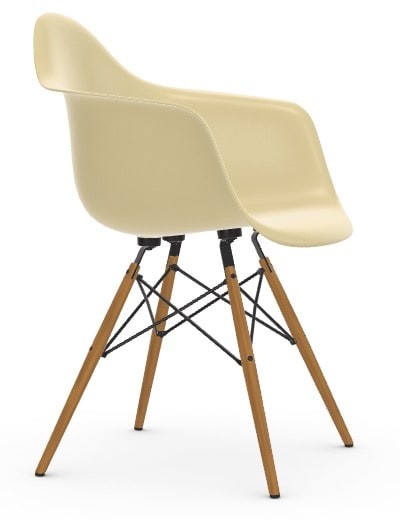Charles & Ray Eames and the fibreglass
Charles & Ray Eames are probably the most influential designer couple of the 20th century. Charles (1907-1978) and his second wife Ray (1912-1988) developed new materials and designs, including their famous fibreglass chairs and other furniture and objects, to provide the post-war world with affordable furnishings. The two designers shaped the Mid Century through their practical designs. In addition to the fibreglass chairs, many icons of design were created in the Eames Office, which is still run by Charles Eames Demetrios, Eames' grandson. Later the Eames also conceived exhibitions and took photographs. In 1957 Willi Fehlbaum acquired a licence from the American manufacturer Hermann Miller for his company Vitra to manufacture the designer furniture of Charles & Ray Eames in Germany and Switzerland; in 1984 the rights to all Eames products for Europe and the Middle East followed.
Fibreglass Chair Design
Today the Fiberglass Chairs are sought-after collector's items. Eames Chairs and other Eames designs can be found in the pro office shop. The Eames Fiberglass Armchairs include the dining room chairs with armrests Vitra Eames DAR (Dining Height Armchair Rod Base) Vitra Eames DAX (Dining Height Armchair X-Base), Vitra Eames DAW (Dining Height Armchair Wooden Base), the rocking chair Vitra Eames RAR (Rocking Armchair Rod Base), the lounge chair with armrests Vitra Eames LAR (Lounge Height Armchair Rod Base), the dining chairs Vitra Eames DSR (Dining Height Side Chair Rod Base) and Vitra Eames DSX (Dining Height Side Chair X-Base) each with a tubular steel frame and the Vitra Eames DSW (Dining Height Side Chair Wood Base) with a wooden base (maple). The non-upholstered models with powder-coated base are also a pleasure to sit on the terrace or in the garden.
Fibreglass chairs go into series production
From 1950 onwards, the fibreglass chairs by Charles & Ray Eames could be produced in series. Various bases and seat shells were produced in many colours. Revolutionary was the manufacturing method, where the fibreglass chairs were produced separately as modules, chair leg and seat shell were produced in different processes and then screwed together. The new process proved to be practical and multifunctional, as the base frames and seat shells can be combined as desired and can fulfil individual living space dreams. The wooden and four-legged underframes made of steel wire and the so-called "Eiffel Tower" have an identical seat height. Eames rethought the chair and designed the first plastic chair that could be produced in series.
Vitra Eames chairs - Fibreglass Armchair
Fibreglass fascinates by its irregular surface and has a natural effect through visible fibres. The original production process became uneconomical and was replaced by high-tech production, which enables Vitra to produce the original Eames Fibreglass chairs. The Fibreglass Chairs are not only available in individual combinations, but also in numerous colours ranging from trendy red to forest green and classic black with a lively texture. The chairs are not only attractive in the dining room, but in the entire living area, office, home office or waiting area. The organic chair design "La Chaise" with a fibreglass seat shell with steel rods on a wooden base, which the Eames submitted to the "International Competition for Low-Cost Furniture Design" at the Museum of Modern Art in 1948, became famous. The legendary chair, however, was not cheap and could not be produced in series at first due to cost reasons.
Fibreglass or fibreglass?
Fibreglass is actually a glass fibre reinforced plastic, GRP is colloquially called fibreglass. The word is an Anglicism borrowed from the English term fibreglass for glass fibre (GFRP - glass-fibre reinforced plastic). Without these fibre-reinforced plastics, many surfaces or products could not be manufactured at all. Duroplastics, such as polyester resin or epoxy resin, or thermoplastics, such as polyamide, have been reinforced with glass fibres since the 1930s. The industrial production of glass fibres began in the USA in 1935. Glass fibre reinforced plastics are high quality, resilient and have a high elasticity.
Durability and recycling at Vitra
Vitra products stand for durability. The selection of classics that remain modern for decades and survive many changes of ownership also includes the fibreglass armchair. The components of the chairs are interchangeable, are manufactured in an environmentally friendly way and can ultimately be recycled. The aluminium parts are always made of remelt alloys. Steel parts can be melted down and recycled. Pure polypropylene and polyamide can be 100% recycled, i.e. melted down. Wood-based materials can be thermally recycled or can be shredded and reused. Vitra offers corporate customers take-back programmes on a contractual basis.






